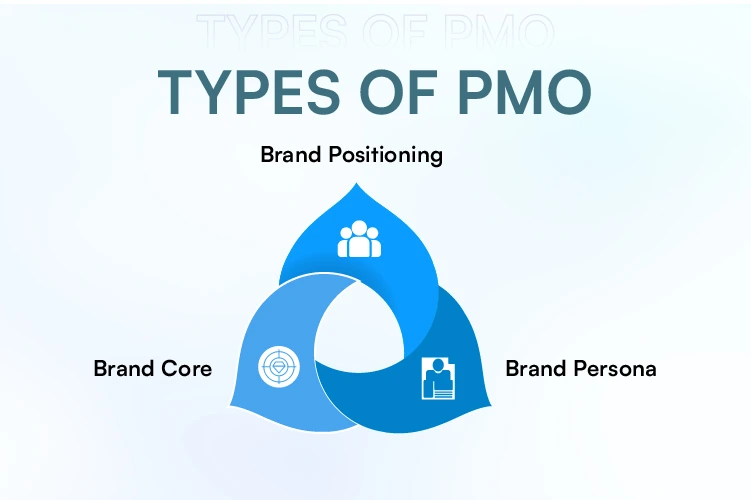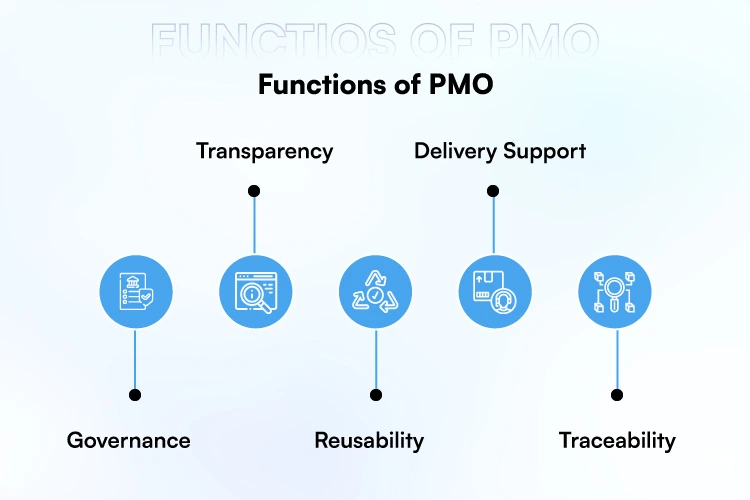PMO is the key location for ensuring that a company’s standards, procedures, and policies are followed to ensure project success. A project management office, according to a study conducted by the Project Management Institute (PMI), promotes the sharing of resources, processes, tools, and techniques.
PMO is effective for establishing similar processes and standards across different organizations that manage many projects in multiple locations. It is also useful to collect project metrics to assess the efficacy of the project management methodology being employed.
But what exactly is a project management office (PMO), and why is it so crucial in business and project management? This blog will guide you through the concept of a project management office in depth. This will assist readers understand how a Project Management Office can aid in the improvement of project management practices, the alignment of projects with corporate goals, and, ultimately, the success of a business.
What is Project Management Office?
PMO is a group of management systems for both external and internal part of an organization, that maintains the standards for project management in the organization. The groups are mainly the gatekeepers of the best practices, project status and directions, all in a single spot.
Any business or organization can always count on assistance from its PMO’s project management team. This office tool can be used throughout the whole project management lifecycle, from planning to execution to final review. The precise actions it takes will, however, change from one organization to the next.
Thus, a Project Management Office keeps project standards up to date and to assist guarantee that projects are finished on schedule, on budget, and up to spec.
Project Management Office Software:
A project management software for a PMO should have:
- Resource Management features.
- Program and Project Portfolio management features.
- Project management software for various project management approaches.
- Project management tools for managing and analyzing teams, as well as collaborative aspects.
To design project and portfolio procedures, allocate resources, and achieve deadlines, PMO software is a web-based collaborative tool. Project management solutions (especially PPM software) provide the functionality and tools necessary for an effective project management office.
The major purpose of PMO software is to assist your team in managing projects that are related to one another while adhering to set norms in order to achieve your overall business goals. Some systems also include standard project management features such as template, task, and process management.
Desktop vs Online PMO Software
Desktop PMO programs are typically more expensive and require installation, as well as additional training time for all users. Because they have various tier memberships, online project management software has numerous price entry points. They are also more user-friendly and intuitive to use.
Both have Benefits and Drawbacks:
The desktop utility will almost always be faster because it is not dependent on an internet connection to decide how soon you receive data. There are also no delays if the internet fails. The desktop is a closed system that can be networked to other computers in the office, but because it is not connected to the internet, your work is safer.
But with enhanced authentication and more granular in-app permissions, online PMO software has come a long way in terms of safety. There is still a delay, albeit it may be negligible depending on your network speed. Nonetheless, they are still considerations when selecting PMO software.
PMO Rules & Responsibilities:
The main purpose of PMO is to coordinate the activities of employees to achieve optimal performance and realize the organization’s objectives. This is accomplished through constant monitoring, performance analysis, and counseling employees based on requirements and observations.
Below have listed down a few rules and responsibilities of PMO:
To create Project Structure
The structure by the PMO to ensures the following:
- Resource utilization is done efficiently.
- Risk assessment is done across the projects.
- Projects progress within the budget & timeline.
To provide Data & Reports to the Management
The Project Management Office collects data and shares it with everyone who needs to know about the project. PMOs are crucial to a project’s success since they collect and report on information for:
- Progress of the project.
- Status of the deliverables.
- Progress on mitigation of the risks.
- Milestones being achieved on time or not.
- Financial Data such as budget, marginal cost, actual cost.
Effective Resource Planning
The PMO team oversees numerous key tasks, such as resource planning. As a result, everyone can know what tools are accessible and plan accordingly. They maintain track of the resource’s vacations, sick days, and other non-project-related events to ensure the optimal use of the resource.
To create Processes and Workflows
The PMO oversees both enhancing existing procedures and developing entirely new ones. Among these are improving the efficiency with which resources are allocated and maintaining accurate records of available resources, such as information about employees’ talents and expertise. The most essential thing is to raise awareness of potential disaster zones before it’s too late to do something about them.
Simplify Communication and Team Collaboration
One of the primary responsibilities of the PMO is to facilitate team communication and collaboration. They must ensure that all teams in different locations are on the same page and that no delays in the performance of assignments occur. All major issues must be addressed immediately, and all problems must be resolved as soon as feasible.
Knowledge Sharing
The project management office guarantees that all project teams share and learn from one another. They save time for the team by distributing documentation, templates, and project plans. All necessary information and documentation are available to the team in one handy spot.
PMO in Web Development:
A project management office’s principal purpose is to create a product that will be helpful to a business. Without a defined plan or direction, a website development team can begin a project. If project management is not employed, more errors and confusion may occur.
PMO provides project managers with a framework for tracking the tasks they oversee. The strategy also aids in keeping things organized and allows project managers to make better use of their time and resources. If you own a business and manage projects, you will benefit from learning PMO, which will help you advance in your career.
Step-by-Step process of PMO in Web Development:
Planning: Planning is the first step of any project. In this step, it’s important to get information from clients that is clear and accurate. This lets the project manager figure out what the client wants and how to get there. Identifying possible risks is another important part of this step. This keeps the project from having to be turned around later, which can cause dates to be missed and costs to go up.
Building: Once the project manager knows what the project is about, they can start working on the product’s plan, design, and functions. The project manager needs to keep an eye on the project and make sure that progress is tracked and shared with the whole team. The team needs to know how quickly they are moving forward and if they are on track with the plan.
Optimization: After the building step is done, it is time to improve the result. This is the process of improving the performance of a product by using tools, advanced strategies, and tests.
Finalization: The last step is to wrap up everything. This step can be complicated and has a few things to do. After making and optimizing the site, the final step is to run the site in-house.
These things are part of the making steps:
- How to keep the team going.
- Getting rid of micromanagement.
- Keeping track of work, tasks, due dates, and budgets.
Below are the steps involved in finalizing a project:
- Testing
- Training
- Go live
- Reporting & Evaluating
- Continuous testing & experimentation
The main purpose of implementing PMO is:
The web development PMO process includes the phases of planning, scheduling, executing, monitoring, and delivering a website. To be more realistic, website development projects should be considered as complex endeavors that necessitate top-level management weighing multiple elements such as cost-benefit analysis, business value, and web development pipeline and process problems.
Web development projects are tough activities that necessitate the leadership of two or more individuals in an ever-changing environment where business management and technology are critical. Create new or improved computer code while considering allocation and execution and working with limited resources (time, money, and manpower).
A web development project is distinguished by a thorough development pipeline that is carried out within a predetermined time frame to produce the desired output, from early requirements collection to final testing and maintenance.
PMO Types:

Supporting PMO
The newly constituted Supporting PMO team assists the Project Manager. They are primarily responsible for the project management information system. They oversee putting protocols, best practices, information access, templates, and training into action.
The most important thing to remember is that they are only being aided by the PMO team; they do not have complete control over the project. They add nothing to the initiative.
Templates, best practices, on-demand information, access to knowledge from other projects, and similar resources are frequently provided by a helpful PMO. If the goal is to create a “clearing house” of project management data that project managers across the organization can easily access, the Supportive PMO is the ideal option.
Controlling PMO
Controlling the PMO ensures that projects follow processes, tools, and standards. As the name implies, the PMO team has some influence, but only to a limited extent. By altering procedures and processes as needed, the controlling PMO team ensures that the team meets milestones on time and without stumbling obstacles.
A controlling PMO can be used in an organization to “rein in” activities, processes, procedures, and documentation. In addition to being offered, the organization requires that the help be used. Adoption of methodologies, templates, and forms; adherence to governance; and use of other PMO-controlled rule systems are examples of requirements.
Directive PMO
The projects are completely directed by the PMO directive. They provide project managers with the necessary tools to administer projects. Projects are managed more professionally, and project managers are required to report back to the directing PMO in order to maintain a high level of consistency in the project work.
This type goes beyond simple control and “takes over” initiatives by providing the necessary resources and project management expertise. Professional project managers from the PMO are assigned to organizations’ newly initiated initiatives. Due to the fact that each project manager originates from and reports back to the director’s PMO, this significantly improves the professionalism of the projects and ensures a high level of consistency in their execution. This is effective in larger organizations with a culture that frequently matrixes out assistance in various areas.
What makes PMO a Good Manager?
Employees in an organization with numerous projects to manage cannot rely on their memories to keep them all organized. Additionally, trying to organize everything via email can only lead to failure. The information must be recorded, deadlines must be planned, and documents must be communicated to complete projects on schedule. Employees must communicate frequently with one another. That is the kind of data that soon outgrows spreadsheets and email threads. Project Management Software is the answer when your team has to take project management seriously. Thus, PMO managers are successful by facilitating project planning, reviewing financial data, altering processes, and ensuring that the projects they oversee have the necessary paperwork. This is accomplished by paying attention to both the little print and the big picture.
Functions of PMO:

Governance: It ensures to provide the correct information to all the stakeholders so that the correct decision is taken on time. They maintain transparency in the project. The workflows are defined by the PMO itself which the company is directed at.
Transparency: PMOs provide information that is relevant and accurate to support effective decision-making for the organization. Thus, they make sure that the right decision is being taken by the organization, based on the right information.
Reusability: It creates a repository for the templates, best practices, and lessons learned from the previous project so that they can be used for new projects.
Delivery Support: PMO streamlines the processes and helps an organization to work efficiently. They facilitate and help them to perform their jobs effectively.
Traceability: It manages documentation, project history and organizational knowledge. It also manages all the artifacts and knowledge of the project.
Top PMO tools:
- ClickUP
- Wrike
- Asana
- Trello
- Workzone
- ProofHub
- MeisterTask
- Teamwork
- Podio
Steps to Choose the Best Project Management Tool
- Define Your Needs.
- Put together an Evaluation Team.
- Test the Tool.
- Get Management Buy-in.
- Purchase and Implement the Tool.
- Review and Iterate.
Benefits of PMO to your Business:
The PMO Offers Guidance:
To begin, a PMO provides a dedicated resource to ensure that all active projects, initiatives, and portfolios are aligned with the long-term goals of the firm. Working within the parameters of a long-term plan, with the assistance of a project management office, allows for more effective decision-making.
Helps Keep Projects on Track:
They act as an external mechanism that ensures the completion of a project. This allows you to respond quickly to problems as they arise, lowering the likelihood of them derailing the project.
PMO has a Big Picture View:
The project team is intimately familiar with the interdependence of the various projects in a portfolio. They are aware of how their interdependence may harm them. This allows you to view the wider picture and how your activities fit into it, which offers you a perspective on the work that isn’t always in your line of sight.
Helps with Communications:
They can also serve as a part of your overall strategy for spreading the word. They can act as a conduit between you and your stakeholders, giving you up to focus on other tasks while ensuring that your message is received and comprehended.
PMO Shares Resources Throughout the Organization:
Resources can be shared when a project management office is established. A program management office can assist you plan how to best use your limited resources across all of your projects or programs if you have limited resources but a lot of initiatives.
When your projects are linked with a business case and plan, you can receive a lot of assistance with tasks such as portfolio management, centralizing training and project management tools, and mentoring. Of course, having a project management office is insufficient. You need good people, tried-and-true procedures, and the correct instruments to get the most out of it.
Conclusion:
As previously said, the success of a PMO is heavily dependent on who oversees promoting it. They will need to demand contentious adjustments on time, so having management’s support and clearly defined roles and responsibilities is critical to their success.
Another factor to consider is the company’s culture; perfecting the Project Management Office may take some time. The project atmosphere must be open and honest for this transition to be effective. As a result, the success or failure of an open corporate culture is determined by how it is implemented.
However, once the PMO is installed and started to assist your initiatives, you will grow to regard it as a vital part of your firm. Project managers who aren’t always skilled at viewing the big picture could utilize this to gain perspective and perform a better job for their teams and clients.
We, Cuneiform Consulting Pvt. Ltd., deal with Project Management Office services and it is one of the best examples of integrated cutting-edge software technology. Technology provides you with a clear picture of your company’s projects, initiatives, and portfolios, which are critical components of successful “project management.” With the support of our professional services PMO allows individuals to collaborate in real time, speeds up project approvals, and eliminates communication obstacles.




